Artnet News Pro
New Tech Is Revolutionizing Art Conservation by Quantum Leaps. Here Are the Tools That Can Safeguard Your Collection
Catch up on these new tools of the trade.
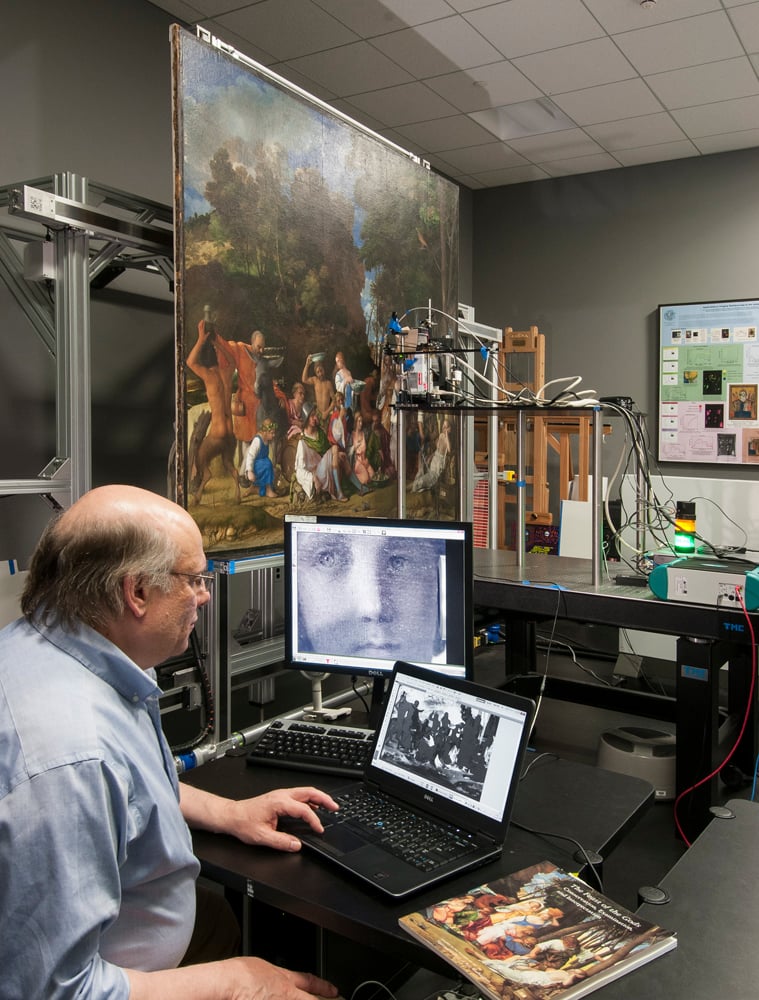
Catch up on these new tools of the trade.

Brian Boucher

Art conservation is likely as old as art-making itself, but the field has transformed dramatically in recent years.
Not only have conservators developed new codes of ethics, they have also been inventive in poaching technologies from fields like biochemistry and geophysics to help them better understand artworks.
Many of the newest technologies being used in the field, as conservator and New York University (NYU) professor emerita Margaret Holben Ellis said, fall under one umbrella: “Imaging, imaging, imaging.”
Some conservators have the luxury of machines that cost hundreds of thousands of dollars to look under the hood of multimillion-dollar paintings. Other times, the newest tools are customized, open-source software that can be used along an off-the-shelf camera.
The trade that used to be referred to as art restoration encompasses much more than just repair. Conservators investigate how objects were made; assess their condition; determine how best to stabilize them; and, when necessary, repair them—reversibly if at all possible.
Since artists are known for exploiting the newest materials, from video to software, conservators, too, have to keep up with the times. NYU even has a new program to train conservators of time-based media, which encompasses everything from videotapes to websites. When possible, conservators consult with the creators themselves. New York’s Whitney Museum of American Art has formalized this process in its Media Preservation Initiative, in which artists advise on how their works can be preserved and repaired in the future.
Here are some of the snazziest tools and technologies conservators are exploiting to investigate, preserve, and repair precious artworks.
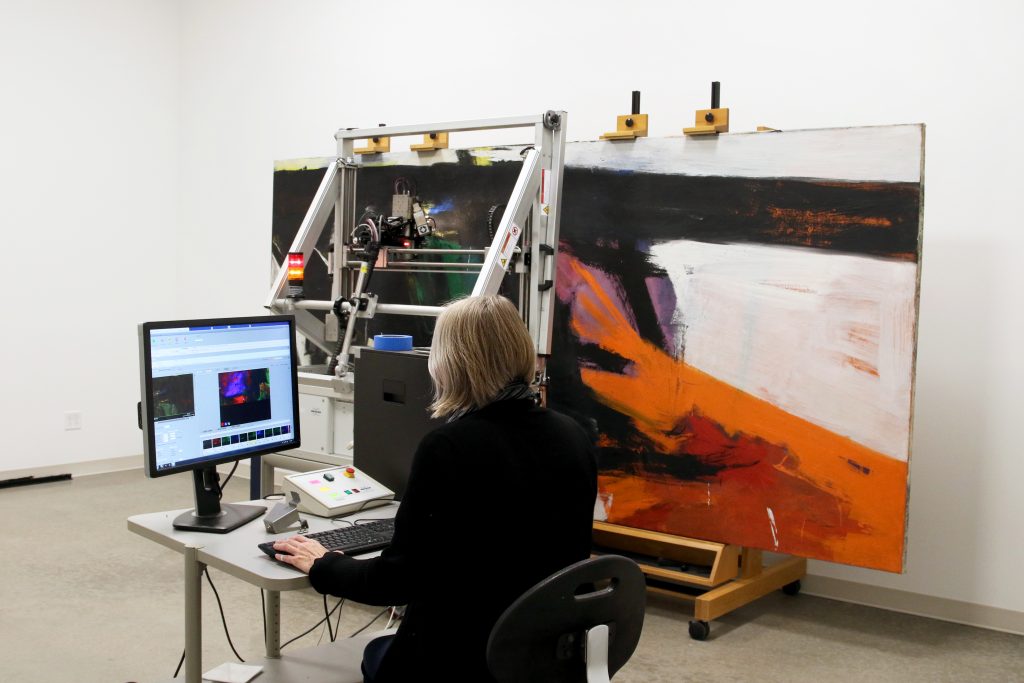
Corina Rogge scanning Orange and Black Wall by Franz Kline. Photo by Sarah Hobson, courtesy Museum of Fine Arts, Houston.
Conservators are always looking for ways to analyze artworks in a non-destructive fashion. One powerful tool in this effort, said Corey Rogge, a research scientist at the Museum of Fine Arts in Houston, is X-ray fluorescence spectroscopy (XRF), a technique used to determine the elemental composition of materials, including those beneath a painting’s surface.
Two years ago, the museum used these tools to analyze Franz Kline’s Orange and Black Wall (1959) using a machine on loan from nSynergies that is a bit beyond Rogge’s budget (it lists at about $350,000).
“We can see several iterations of the composition,” Rogge said. “Some areas that are now black or white were once bright red. We can get an idea of how [Kline’s] vision for the work evolved and changed, which is useful since most artists don’t write about their process.”
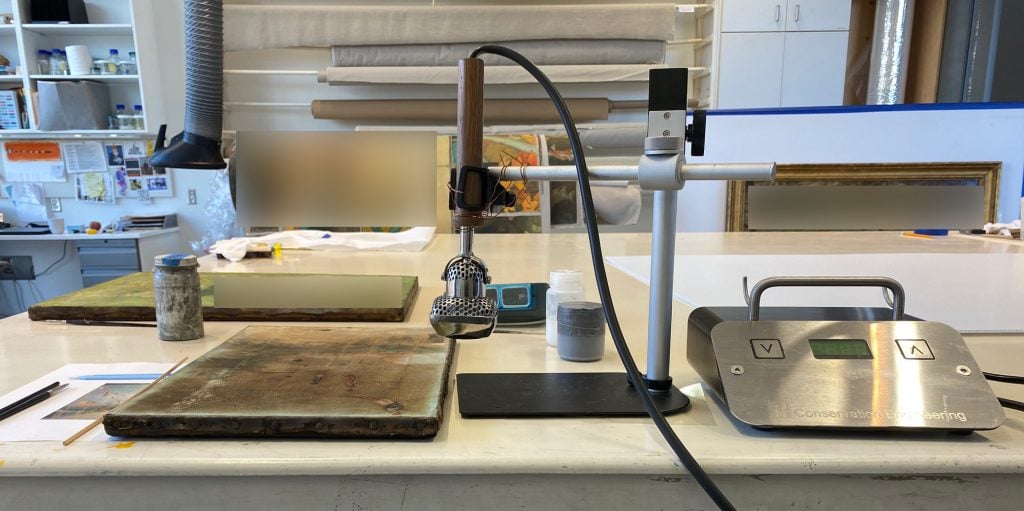
Non-contact infrared heat tool, designed by Robin Hodgson. Courtesy Williamstown Art Conservation Center.
Not every museum has its own in-house conservator, and institutions throughout the Northeast U.S. rely on the Williamstown Art Conservation Center for help. One of its tools is a non-contact infrared heat tool designed by an Australian engineer named Robin Hodgson—“a famous savior in the world of art conservation,” said Maggie Barkovic, the center’s associate paintings conservator.
The device, Barkovic said, “allows us to work on paintings that have raised, brittle, flaking paint to prevent fractures and paint loss. It allows us to consolidate the flaked paint, or reattach it, safely, without touching the paint.”
If a painting is damaged by fire, for example, its paint can become blistered.
“In localized cases, brittle heat blisters erupt after the fire and incur loss, requiring immediate adhesion,” she said. “For paintings that withstand the brunt of the fire, the paint film is so brittle that humidification and a non-contact Infrared heat tool [can be] necessary to prevent further loss.”
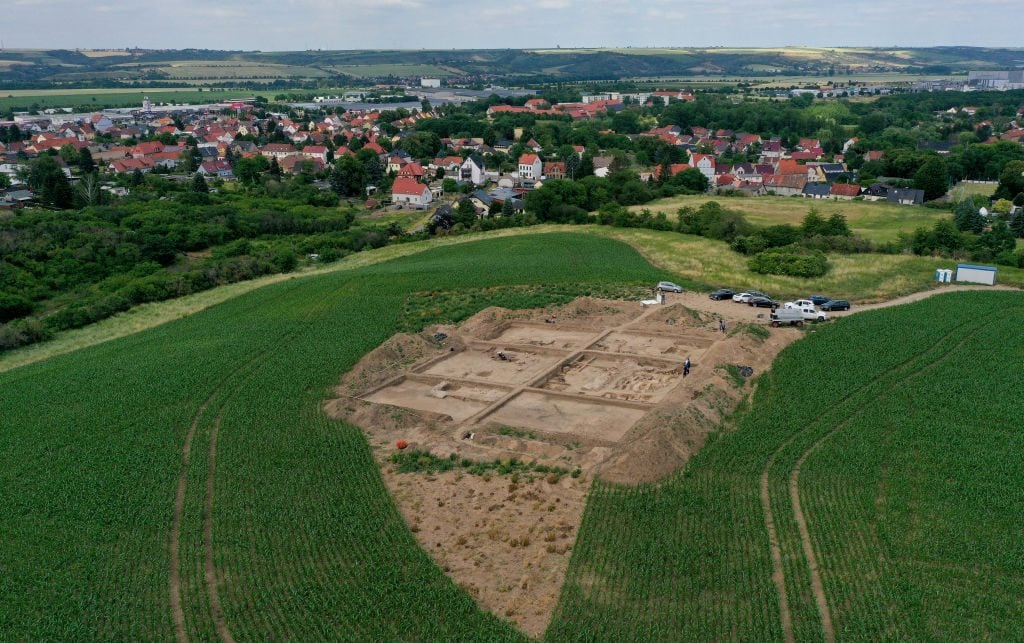
An excavation of the recently rediscovered royal palace of Helfta. Photo: Ronny Hartmann/dpa (Photo by Ronny Hartmann/picture alliance via Getty Images)
Conservators are doing exciting work with 3D imaging, said Emily Frank, conservator at the Cooper Hewitt Design Museum and a consultant at NYU’s Institute for the Study of the Ancient World.
“Especially with large monuments, you can collaborate on a global scale,” she said—which is especially important during the coronavirus pandemic, when scientists can’t travel freely to the sites under study. “With tools like this, you can detect changes in objects over time.”
Reflectance transformation imaging is 2½D, Frank said. “You can use RTI to capture an image and run it through software and virtually move light around a surface on a detailed level.” That’s especially useful for studying objects with inscriptions that must be examined on a micro scale in a raking light.
“You often can’t move ancient art around because it’s huge, and since it’s often in sunlight all day, it’s hard to see faded or shallow inscriptions,” she said.
But her work is frequently fairly low-tech: “I often use inexpensive, off-the-shelf camera equipment to create cutting-edge outputs by using free or open-source software like ImageJ and Python.”
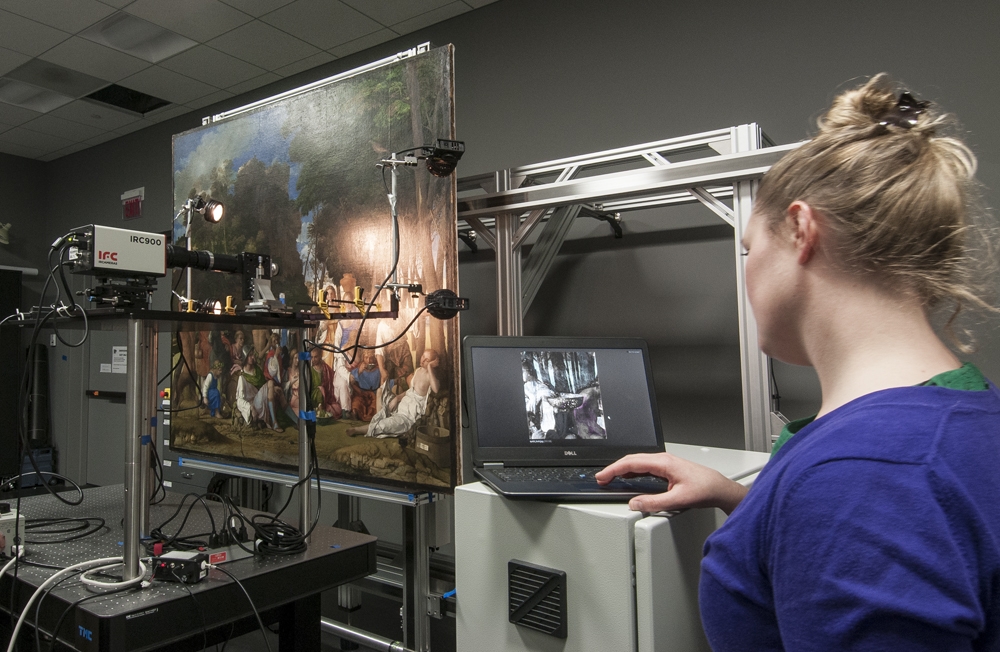
Kathryn Dooley, imaging scientist, conducts imaging of Giovanni Bellini and Titian’s The Feast of the Gods (1514/1529). Courtesy National Gallery of Art.
If you watched the Mars Perseverance rover as it analyzed the geology of the Red Planet, you are clued in to a technology that John Delaney, senior imaging scientist at the National Gallery of Art, in Washington, D.C., is using to explore artworks.
While NASA uses reflectance imaging spectroscopy (RIS) to look for minerals that would have formed in watery conditions (the foundational conditions for life as we know it), Delaney uses RIS to identify the minerals in paintings by artists such as Giovanni Bellini and Jackson Pollock.
An emerging field at museums, RIS is used at only a handful of institutions.
“Companies do sell hyperspectral imaging cameras, which are very popular in remote sensing of the Earth, but those are much more brightly lit conditions than museums,” Delaney said. “We have to modify them to increase their sensitivity, so we are putting our own camera systems together.” Major institutions like the National Gallery in London and the Getty Museum in California are following his lead.
One recent project of Delaney’s was to study The Feast of the Gods (1514/1529), a canvas painted by Bellini and later modified not only by Dosso Dossi but also Titian, to determine which artist was responsible for which elements of the painting, and to create an image of what the work looked like before Dossi and Titian’s interventions.
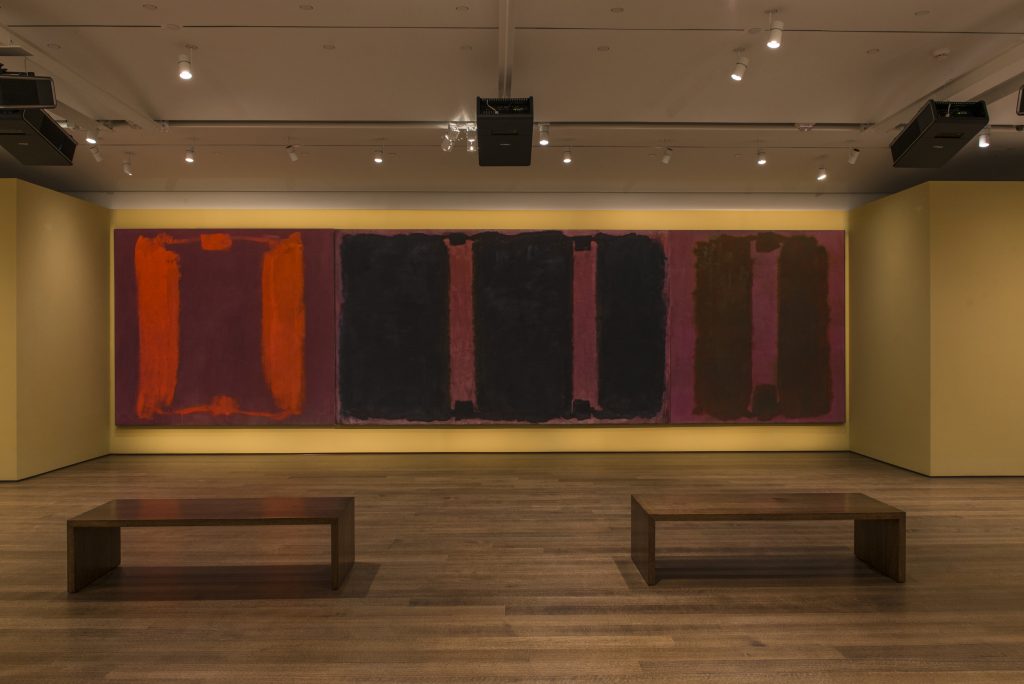
Mark Rothko’s Panel One, Panel Two, and Panel Three (Harvard Mural Triptych), with restored colors using light from digital projectors. © 2014 Kate Rothko Prizel and Christopher Rothko / Artists Rights Society (ARS), New York. Photo: Peter Vanderwarker; courtesy Harvard Art Museums.
Another leader in the field is the Harvard Art Museums’ Straus Center for Conservation and Technical Studies, often referred to as the jewel in the museums’ crown.
The Straus Center worked to triumphantly bring a set of murals by Mark Rothko that had been exposed to direct sun for decades back to public view. With the help of digital projections, its scientists were able to mimic the works’ original appearance.
During the analysis of the paintings, experts used LDI-TOF-MS (or—deep breath!—laser desorption ionization time of flight mass spectrometry) to analyze the paintings’ pigments.
The technology was introduced to Straus by an expert in the pharmaceuticals industry. “We were the lab that introduced it to the field,” said Narayan Khandekar, the center’s director.
To analyze the materials that bind the pigment together, meanwhile, they used (another deep breath!) LCMSMS (microcapillary liquid chromatography tandem mass spectrometry) and PMF (peptide mass fingerprinting).
These technologies allow incredibly precise and minute identification of materials. For example, LCMSMS helped determine exactly what kind of eggs Rothko had used in his binder.
“We can identify things down to the species level,” Khandekar said. “This may sound trivial. But if you’re looking at a medieval manuscript, the artists may have used chicken egg, not duck egg or goose egg. They made very specific choices.”
“All this information helps us know how to care for objects,” he said. “The best form of conservation is preventative.”
Despite all the bells and whistles, the ultimate end remains the same.
“The goal hasn’t changed at all, which is to understand art, what it means, how it’s made, what it’s made of and how to care for it,” he said. “These simple goals are still in place, though we have sophisticated tools to answer those questions. That’s what it’s all about.”